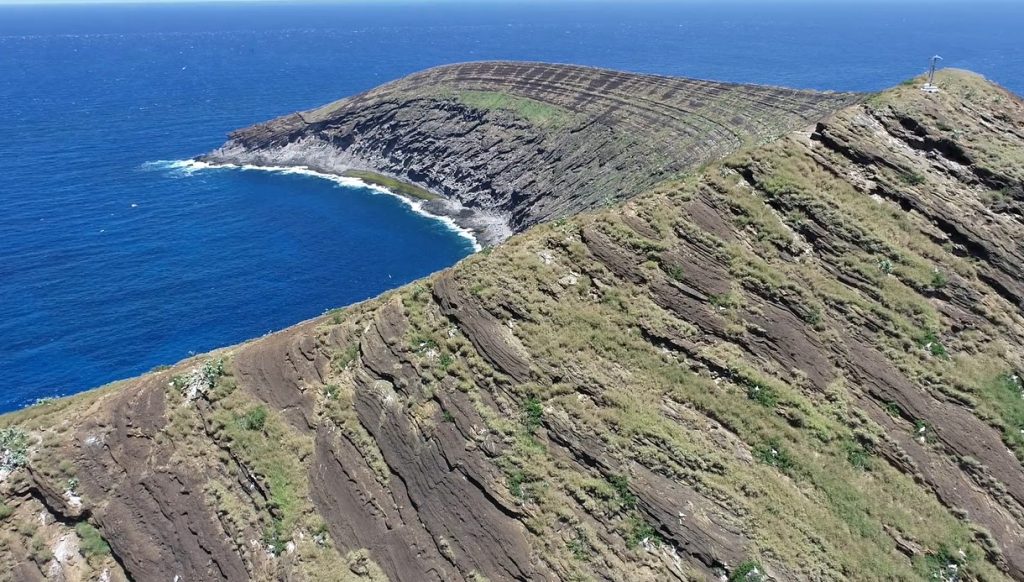01/25/23 – LEHUA ISLAND RESTORATION CONTINUES WITH SEABIRD SOCIAL ATTRACTION PROJECTS
Posted on Jan 25, 2023 in Forestry & Wildlife, News Releases
| JOSH GREEN, M.D. GOVERNOR |
DAWN CHANG |
For Immediate Release: January 25, 2023
LEHUA ISLAND RESTORATION CONTINUES WITH SEABIRD SOCIAL ATTRACTION PROJECTS
To view video please click on photo or view at this link: https://vimeo.com/237687215
(Lehua Islet) – After being declared rat-free in 2021, restoration and monitoring efforts continue on Lehua Islet (Lehua), a small, uninhabited island off the west coast of Kauaʻi. Monitoring of native seabird species breeding on the islet by the Kauaʻi Endangered Seabird Recovery Project (KESRP) and the DLNR Division of Forestry and Wildlife (DOFAW) indicates a success story, based on increased reproductive success following eradication of the rat population. Work on Lehua is now in the restoration phase. Lehua is a State Seabird Sanctuary managed by DOFAW.
The restoration work on the islet aims to attract more native species and establish breeding populations of endangered native birds. Social attraction systems were installed at two different sites on the island this month.
One of the sites, targets several tern species no longer on Lehua: ʻewaʻewa or Sooty Tern, pākalakala or Gray-backed Tern, and the hinaokū or Blue-gray Noddy. Among these species, ʻewaʻewa currently breed on nearby Kaʻula Islet. This is the first social attraction project for terns in the Hawaiian Islands. These focal tern species are protected by the Federal Migratory Bird Treaty Act and State law.
Thirty tern decoys, a sound system, and ten mirror boxes are in place at the site. This method has been used successfully for terns in other parts of their range and are effective because of the nature of these species. ʻEwaʻewa, in particular, will nest in extremely large colonies. It is thought that these large aggregations help birds reduce predation threats and communicate key foraging between birds. The creation of an apparent colony through decoys, mirror boxes, and calls played through sound systems helps to create what appears to be a large active tern colony. This attracts prospecting birds into the area and helps promote breeding behavior.
For the endangered ‘akē’akē or Band-rumped Storm-petrel and ʻuaʻu or Hawaiian petrel, KESRP deployed artificial nest boxes, a social attraction sound system, and monitoring cameras. This technique has been successfully used in other parts of the world for this species. Band-rumped Storm-petrels are regularly recorded calling around Lehua, but a burrow has never been located. This is the first Band-rumped Storm-petrel social attraction project in Kauaʻi County.
‘Akē’akē are listed as endangered by the federal and state governments and there is no known accessible colony on Kauaʻi, making management challenging. If successful, this project will enhance breeding distribution of ‘akē’akē and create an accessible colony which will increase knowledge, research, and conservation management of the species.
This work was partially funded by a U.S. Fish and Wildlife Competitive State Wildlife Grant, and the National Fish and Wildlife Foundation, as well as by state funds. Volunteers and Kauaʻi-based Archipelago Research and Conservation helped the project team install the social attraction systems on Lehua.
# # #
RESOURCES
(All images/video courtesy: DLNR)
HD video – Lehua Island: Restoration of a Tropical Bird Paradise TV special (July 2021): https://vimeo.com/237687215
HD video – Drone aerials of Rat Free Lehua (July 8, 2021): https://vimeo.com/539311331
Photographs – Lehua Island Aerials (Feb. 21, 2017): https://www.dropbox.com/sh/yqsy76e57xunmxg/AABWawQHLCkwL7F1y-ZyYEJpa?dl=0
Media Contacts:
Madison Rice
Communications Specialist
Dan Dennison
Senior Communications Manager


